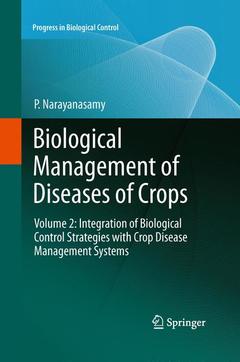Description
Biological Management of Diseases of Crops, Softcover reprint of the original 1st ed. 2013
Volume 2: Integration of Biological Control Strategies with Crop Disease Management Systems
Progress in Biological Control Series, Vol. 16
Author: Narayanasamy P.
Language: English
Subjects for Biological Management of Diseases of Crops:
Approximative price 210.99 €
In Print (Delivery period: 15 days).
Add to cartPublication date: 07-2015
Support: Print on demand
Approximative price 210.99 €
In Print (Delivery period: 15 days).
Add to cartPublication date: 06-2013
364 p. · 15.5x23.5 cm · Hardback
Description
/li>Contents
/li>Comment
/li>
Biological management of diseases of crops is influenced by the nature of interactions between the pathogens and other organisms and the plants. Due to development of resistance in pathogens to fungicides and bactericides, determination of compatibility of biotic biocontrol agents with chemicals is essential for selecting strains of biocontrol agents (BCAs) showing resistance to chemicals to effectively restrict use of the chemicals. Microbial plant pathogens and the antagonists present in the soil and on the plant surfaces are influenced by various cultural practices. It is possible to reduce disease incidence and intensity by crop sanitation and using appropriate rotational crops. Application of physical techniques involving the use of heat, solarization and irradiation has potential to reduce the pathogen population or weaken the potential of pathogens present in the seed, planting materials and soil.
Preface
Acknowledgement
1. Introduction
1.1 Concepts and aims of biological management of diseases of crops
1.2 Land marks in the development of biological disease management systems
1.3 Biological disease management strategies
1.4 Integration of biological disease management strategies
2. Cultural practices influencing biological management of crop diseases
2.1 Crop sanitation
2.2 Crop nutrition
2.3 Tillage
2.4 Soil flooding
2.5 Planting date and density
2.6 Irrigation practices
2.7 Effects of other crops
2.8 Effects of cultural practices on soil microbial communities
3. Physical techniques for biological crop disease management
3.1 Heat treatments
3.2 Solar energy treatments
3.3 Radiation treatments
3.4 Ozone treatment
4. Biological control of microbial plant pathogens in alternative sources of infection
4.1 Biological control of weeds
4.2 Biological control of insect vectors by microbial pathogens
5. Development of formulations and commercialization of biological products
5.1 Development of formulations
5.2 Delivery systems for formulated products
5.3 Registration and commercialization of biological control agents
6. Biological disease management systems for agricultural crops
6.1 Diseases of cereal crops
6.2 Diseases of cotton
6.3 Diseases of pulse crops
6.4 Diseases of oilseed crops
6.5 Postharvest diseases
7. Biological disease management systems for horticultural crops
7.1 Management of diseases of vegetables
7.2 Management of diseases of fruits
7.3 Management of diseases of plantation crops
Discussion on the biological activities of both biotic and abiotic bioagents under natural field conditions is presented with several illustrations only in this book, providing a significant benefit and opportunity to the audience to have complete information from a single source
Information on the biological management of postharvest diseases, weeds and vectors of diseases that form additional sources of inoculum and various procedures followed for formulation and commercialization of bioproducts is included in this book to provide additional advantage to the audience
Presentation of case studies of integrating different biological control strategies compatible with crop production systems for the effective management of diseases caused by microbial pathogens is yet another attempt to make the book to be more useful to the readers who cannot find this aspect in any other book




